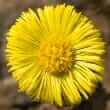Background
- Coltsfoot (Tussilago farfara), a member of the Asteraceae family, is native to Europe and Asia. It is presumed to have been introduced to the United States by settlers for medicinal purposes. Today, coltsfoot has spread into the northern and middle Atlantic, Midwest, and northern Pacific areas of the United States. It is currently listed as a noxious or invasive weed in several states in the United States.
- The leaves and flowering stems of coltsfoot have a long history of medicinal use as an expectorant (to release mucus) and cough suppressant, hence the name tussilago, which translates to cough suppressant. Coltsfoot has been used to treat other respiratory conditions, including asthma, emphysema, and smoker's cough. Coltsfoot has also been used as an astringent, as a demulcent (to soothe mucous membranes), and as a poultice for eczema, skin ulcers, insect bites, and other inflammatory skin conditions.
- The flowers and young leaves are edible and may be consumed either raw or cooked. The rootstock has been used to make a sweet syrup.
References
Natural Standard developed the above evidence-based information based on a thorough systematic review of the available scientific articles. For comprehensive information about alternative and complementary therapies on the professional level, go to . Selected references are listed below.
- Fu JX. [Measurement of MEFV in 66 cases of asthma in the convalescent stage and after treatment with Chinese herbs]. Zhong Xi Yi Jie He Za Zhi 1989;9(11):658-9, 644.
View Abstract - Hwang SB, Chang MN, Garcia ML, et al. L-652,469--a dual receptor antagonist of platelet activating factor and dihydropyridines from Tussilago farfara L. Eur J Pharmacol 1987;141(2):269-281.
View Abstract - Klepser TB, Klepser ME. Unsafe and potentially safe herbal therapies. Am J Health Syst Pharm 1999;56(2):125-138.
View Abstract - Li YP, Wang YM. Evaluation of tussilagone: a cardiovascular-respiratory stimulant isolated from Chinese herbal medicine. Gen Pharmacol 1988;19(2):261-263.
View Abstract - Roder E, Wiedenfeld H, Jost EJ. [Tussilagine - a New Pyrrolizidine Alkaloid from Tussilago farfara.]. Planta Med 1981;43(9):99-102.
View Abstract - Sperl W, Stuppner H, Gassner I, et al. Reversible hepatic veno-occlusive disease in an infant after consumption of pyrrolizidine-containing herbal tea. Eur J Pediatr 1995;154(2):112-116.
View Abstract - Turker AU, Usta C. Biological screening of some Turkish medicinal plant extracts for antimicrobial and toxicity activities. Nat Prod Res 2008;22(2):136-46.
View Abstract - Willett KL, Roth RA, Walker L. Workshop overview: Hepatotoxicity assessment for botanical dietary supplements. Toxicol Sci 2004;79(1):4-9.
View Abstract - Zeller W, de Gols M, Hausen BM. The sensitizing capacity of Compositae plants. VI. Guinea pig sensitization experiments with ornamental plants and weeds using different methods. Arch Dermatol Res 1985;277(1):28-35.
View Abstract







